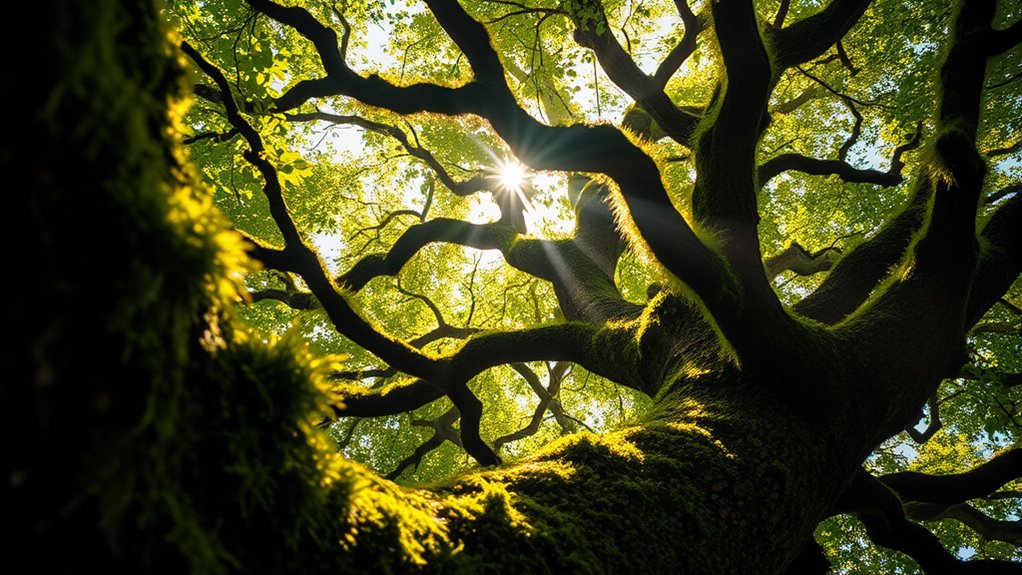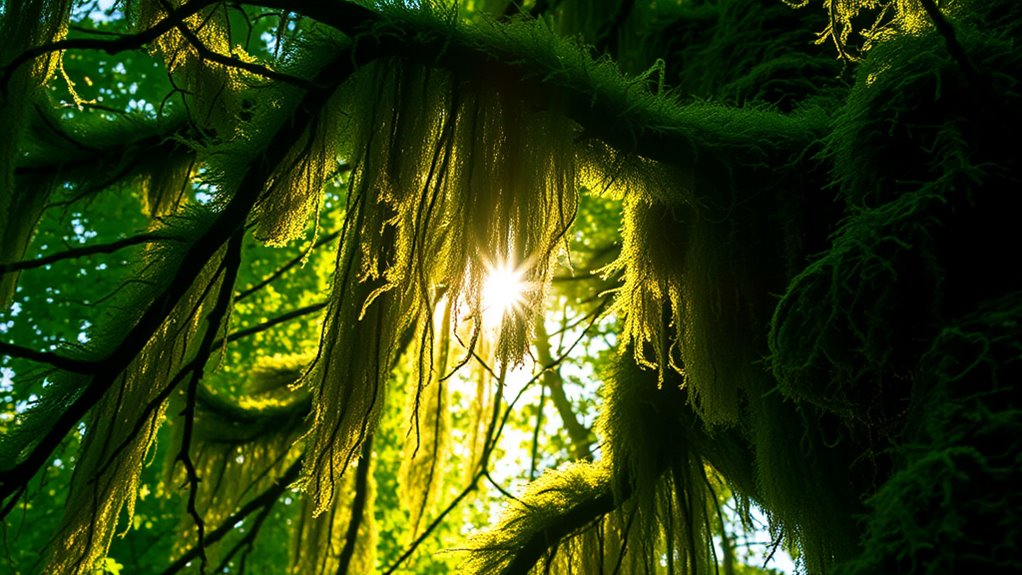To navigate using the canopy, observe moss growth on trees; it tends to grow on the damp, shaded side, usually the north in the Northern Hemisphere, helping you find a general direction. Use the sun’s position—rising in the east, setting in the west, and high at midday—to refine your orientation based on the time of day. Combining these natural cues enhances your sense of direction, and if you keep exploring, you’ll discover more about finding your way without a compass.
Key Takeaways
- Moss typically grows on the shaded, damp side of trees, often indicating north in the Northern Hemisphere.
- Observe the sun’s position: rising in the east, setting in the west, and highest at midday to estimate south.
- Use moss growth as a general guide but verify with sun movement, considering environmental factors that may affect moss.
- Track the sun’s angle and movement over time to refine your sense of direction without tools.
- Combine moss cues with sun observations for more accurate navigation toward home.

When you’re lost in the wilderness, using natural cues can be a lifesaver. One of the most reliable methods involves observing moss growth patterns and tracking the sun’s position to orient yourself. Moss tends to grow in specific areas on trees, which can give you subtle clues about direction. Typically, moss favors the damp, shaded side of a tree, which in the Northern Hemisphere is usually the north side. By carefully examining the moss growth patterns on nearby trees, you can identify which side faces away from the sun and is often more humid and shaded. This can help you determine north, giving you a rough compass to guide your movements. Keep in mind, though, that moss can sometimes grow on other sides if the environment is particularly moist or shaded, so it’s best to use this cue in conjunction with other natural indicators.
Tracking the sun’s position is another essential technique. The sun rises roughly in the east and sets in the west, although its exact position varies through the year. When the sun is visible, you can estimate direction by noting its position in the sky. In the morning, the sun will be in the eastern part of the sky; in the evening, it will be in the west. As the day progresses, the sun moves across the southern part of the sky in the northern hemisphere, providing a rough east-to-west guide. If you don’t have a watch or a compass, you can use the sun’s angle to determine your orientation. For example, if you see the sun high in the sky around midday, you know it’s roughly south in the northern hemisphere. By observing the sun’s movement over the day, you can establish a makeshift compass and navigate toward familiar landmarks or water sources. Additionally, understanding the sun’s angle can help you estimate your latitude and better interpret your environment.
Combining these natural cues enhances your chances of finding your way. Look for moss growth patterns to establish a general north-south axis, then use the sun’s position to refine your direction. Remember, environmental factors like cloud cover or dense foliage can obscure the sun, so don’t rely solely on one method. Just as importantly, stay calm and keep evaluating your surroundings. Every detail—the moss, the sun, the shape of the land—can help you piece together the puzzle and guide you back to safety. These natural navigation tricks aren’t foolproof but can be invaluable when traditional tools aren’t available. Practice observing these cues before heading into the wilderness, so they become second nature if you ever need them in an emergency.
Frequently Asked Questions
Can Moss Grow Equally on All Sides of Trees Year-Round?
Moss growth patterns aren’t equal on all sides of trees year-round. Typically, moss prefers the cooler, shaded side, which is often the north side in the Northern Hemisphere. Tree bark textures also influence moss growth; rougher textures hold more moisture, encouraging moss. So, you’ll notice moss tends to grow more on certain sides, depending on sun exposure, moisture, and bark texture, rather than uniformly around the tree.
How Do Weather Changes Affect Sun Angle Navigation?
Ever wondered how weather pattern shifts affect your navigation? Changes in weather and seasonal sun movement can alter the sun’s position in the sky, making it trickier to rely solely on sun angles. Cloud cover, storms, or overcast skies can block sunlight, disrupting your sense of direction. So, it’s wise to combine sun navigation with other cues, especially during unpredictable weather, to stay on course and find your way home confidently.
Are There Specific Tree Species Better for Moss-Based Navigation?
You might wonder if certain tree species are better for moss-based orientation. Generally, moss prefers trees with rough bark and consistent moisture, like oak and pine. These species provide stable surfaces and a damp environment, encouraging moss growth. By recognizing moss preferences and tree species, you can better use moss as a natural indicator when navigating through forests, especially when other cues like the sun or compass are less reliable.
What Tools Can Complement Moss and Sun Angle Navigation Methods?
Ever thought moss and sun angles aren’t enough? Well, add a compass to keep your sense of direction sharp and avoid wandering aimlessly. A map, especially if you can calibrate your compass with it, makes your navigation foolproof. A GPS device adds tech flair, but don’t rely solely on batteries—your skills with moss and sun angles keep you grounded when gadgets fail. Stay prepared, explorer!
How Accurate Is Moss and Sun Angle Navigation in Different Climates?
You might wonder how reliable moss and sun angle navigation is across different climates. Climate variability and seasonal shifts can impact moss growth and sun position, making these methods less accurate at times. In wetter, moss-rich environments, moss navigation is more dependable, but in dry or seasonal climates, it’s trickier. Sun angles may also shift with seasons, so it’s best to combine these techniques with other navigation tools for better accuracy.
Conclusion
Imagine trusting the silent whispers of the forest—moss on the north side and the sun’s angle guiding your way. While not a foolproof compass, these natural signs can help you find your footing in the wilderness. By observing your surroundings, you connect with the ancient dance of nature, feeling grounded and confident. Sometimes, the forest offers subtle clues, leading you home if you’re willing to look closely and trust its quiet wisdom.










